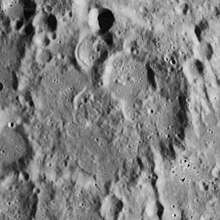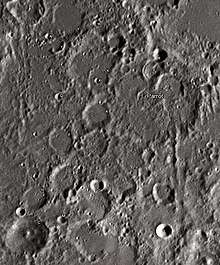Parrot (crater)
Parrot is the remains of a lunar impact crater that has been almost completely worn away. It was named after Russian doctor and physicist Friedrich Parrot.[1] It is attached to the southern rim of the crater Albategnius, and is located among the rugged highlands among the south-central part of the visible Moon. To the east is the small crater Vogel, and in the southeast is Arzachel.
 Lunar Orbiter 4 image | |
| Coordinates | 14.5°S 3.3°E |
|---|---|
| Diameter | 70 km |
| Depth | 1.1 km |
| Colongitude | 357° at sunrise |
| Eponym | Friedrich Parrot |

Little remains of the southwestern rim of Parrot, and the other sections of the wall have been worn and smoothed by impact erosion. The remains of a pair of overlapping craters occupy much of the northern floor of the crater, and the remainder is irregular but relatively flat. No central peak remains.
A groove structure intersects the southeast and part of the northern rim, following an intermittent line from the south-southeast to the north-northwest.
Satellite craters

By convention these features are identified on lunar maps by placing the letter on the side of the crater midpoint that is closest to Parrot.
| Parrot | Latitude | Longitude | Diameter |
|---|---|---|---|
| A | 15.3° S | 2.1° E | 21 km |
| B | 13.6° S | 2.5° E | 10 km |
| C | 18.5° S | 1.2° E | 31 km |
| D | 14.2° S | 3.6° E | 21 km |
| E | 16.0° S | 2.3° E | 20 km |
| F | 16.1° S | 1.4° E | 19 km |
| G | 17.4° S | 2.6° E | 28 km |
| H | 17.6° S | 1.2° E | 19 km |
| J | 17.0° S | 1.8° E | 23 km |
| K | 14.1° S | 1.8° E | 44 km |
| L | 18.0° S | 0.9° E | 7 km |
| M | 18.0° S | 2.0° E | 7 km |
| N | 13.8° S | 0.5° E | 5 km |
| O | 16.9° S | 2.6° E | 10 km |
| P | 18.6° S | 3.0° E | 6 km |
| Q | 15.1° S | 1.1° E | 5 km |
| R | 13.5° S | 3.2° E | 10 km |
| S | 15.9° S | 3.6° E | 10 km |
| T | 15.9° S | 4.2° E | 8 km |
| U | 14.1° S | 4.5° E | 10 km |
| V | 13.2° S | 0.8° E | 24 km |
| W | 13.2° S | 1.5° E | 5 km |
| X | 14.5° S | 1.9° E | 4 km |
| Y | 13.9° S | 0.7° E | 10 km |
References
- "Parrot (crater)". Gazetteer of Planetary Nomenclature. USGS Astrogeology Research Program.
- Andersson, L. E.; Whitaker, E. A. (1982). NASA Catalogue of Lunar Nomenclature. NASA RP-1097.CS1 maint: ref=harv (link)
- Bussey, B.; Spudis, P. (2004). The Clementine Atlas of the Moon. New York: Cambridge University Press. ISBN 978-0-521-81528-4.CS1 maint: ref=harv (link)
- Cocks, Elijah E.; Cocks, Josiah C. (1995). Who's Who on the Moon: A Biographical Dictionary of Lunar Nomenclature. Tudor Publishers. ISBN 978-0-936389-27-1.CS1 maint: ref=harv (link)
- McDowell, Jonathan (July 15, 2007). "Lunar Nomenclature". Jonathan's Space Report. Retrieved 2007-10-24.CS1 maint: ref=harv (link)
- Menzel, D. H.; Minnaert, M.; Levin, B.; Dollfus, A.; Bell, B. (1971). "Report on Lunar Nomenclature by the Working Group of Commission 17 of the IAU". Space Science Reviews. 12 (2): 136–186. Bibcode:1971SSRv...12..136M. doi:10.1007/BF00171763.CS1 maint: ref=harv (link)
- Moore, Patrick (2001). On the Moon. Sterling Publishing Co. ISBN 978-0-304-35469-6.CS1 maint: ref=harv (link)
- Price, Fred W. (1988). The Moon Observer's Handbook. Cambridge University Press. ISBN 978-0-521-33500-3.CS1 maint: ref=harv (link)
- Rükl, Antonín (1990). Atlas of the Moon. Kalmbach Books. ISBN 978-0-913135-17-4.CS1 maint: ref=harv (link)
- Webb, Rev. T. W. (1962). Celestial Objects for Common Telescopes (6th revised ed.). Dover. ISBN 978-0-486-20917-3.CS1 maint: ref=harv (link)
- Whitaker, Ewen A. (1999). Mapping and Naming the Moon. Cambridge University Press. ISBN 978-0-521-62248-6.CS1 maint: ref=harv (link)
- Wlasuk, Peter T. (2000). Observing the Moon. Springer. ISBN 978-1-85233-193-1.CS1 maint: ref=harv (link)